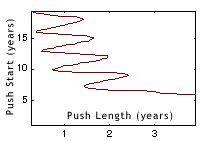May We Deflect an Asteroid?

The deflection of a large body is a daunting task that requires top level technologies and new design methodologies, and most of all it requires a lot of time. But it is nevertheless possible. Many deflection concepts have been proposed in recent years, many lacking of an appopriate theoretical analysis. Within the European Space Agency, the Advanced Concepts Team studied and developed early on tools to perform trade-offs among deflection options.
The deflection formula
Deflection strategies act on the asteroid by means of some force interaction (gravitational, propulsion, impact) the goal of a deflection effort is, of course, to increase the miss-distance between the Earth and the asteroid to some predefined security value (10000 Km is a typical value). Regardless of the deflection strategy choosen, the resulting Earth miss distance is governed by a simple equation we developed and called Asteroid Deflection Formula.
The formula is valid for long term deflections, that is in those cases in which a good planning is possible of a deflection countermeasure. It tells us a number of things that improve our understanding on the asteroid deflection mechanism.
Applying the defelction along the velocity vector is a good choice in most cases. The deflection has a greater effect on the miss distance if performed during a high velocity regime (perihelium). If a fixed inertial direction has to be chosen for the deflection action (having the capability of thrusting for a long time), the one perpendicular to the asteroid eccentricity vector and lying on the orbital plane is a good choice.
A simple example
A back of the envelope calculation might clarify the challenges of this problem. Say we have an asteroid of 200m of diameter, assuming an average density of 2.6 Kg/m^3, its mass will roughly be 1e10 Kg. The orbit of the asteroid is assumed to have a .7 eccentricity and a 3.7 AU semi-major axis. Say we want to assess the deflection concept of attaching some engines to the asteroid.
Assuming we are able to deliver an optimistic costant thrust level of 2N (high specific impulse engines are likely to be employed) and a perfect alignment between the thrust and the velocity vector (impossible to obtain if the engines are attached on the asteroid surface) the graph on the left is returned by the deflection formula (a 10000 Km miss distance contour line is shown). Even in this ideal case, the deflection appears to be quite demanding. In fact if we desire to deflect the asteroid in less than 10 years we need to be able to deliver the thrust level for at least 11 months. The whole mission would anyway be quite lengthy. Another popular deflection concept often to be assessed is that of a kinetic impactor. In this case the miss distance simplifies.

Again some fast calculation shows that in the case previously discussed a value of 1.5e7 is needed for the product (eta)mtsvU where ts is expressed in years. This, given that we manage to properly design the impactor trajectory and shape, may require an impactor mass as high as 10000 Kg.
These back of the envelope calculations shows how difficult it can be to deflect an asteroid and what technology challenges it could pose. Things, fortunately are not always this bad. They can be much better, but also much worse. As an example, repeating the calculations for asteroids that are of a larger size, say 1 km, not much can be done (essentially they cannot be deflected, only destroyed....).
The case of apophis
We cannot escape but shortly speak about Apophis. This asteroid is named after the greek Good of Chaos and owes its name to his orbit that will bring it to come very close to the Earth in 2029 to then modify its orbit and return to our planet in 2036 at a distance that is hardly predictable and whose estimate has been subject of quite some discussion. The Advanced Concepts Team studied the possible delfection options for this asteroid already when it was called 2004 MN4, that is from the very early days of the warning. Fortunately, Apophis (with a very small chance) would need to be deflected of a very small amount (1km roughly) and launch windows exist to perform such a deflection as late as 2026 (three years before its 2029 close encounter) with a 700kg spacecraft. After this date the task of deflecting the asteroid would become much larger and numbers would look a bit like those in the example above. Apophis is a good study case for the international community as it represents an as-real-as-it-gets scenario to challenge us in developing our technologies in case a real threat one day would come.